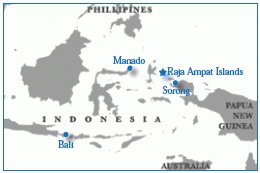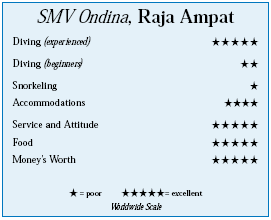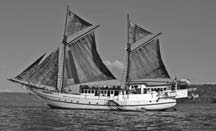SMY Ondina, Raja Ampat, West PapuaContents of this Issue: SMY Ondina, Raja Ampat, West Papua When You Decide To Go It Alone Younger, Newer and Female Divers Show More DCI Symptoms So How Many Divers Are There, Really Irrational Fear of Flashing Dive Computers Regulators: Two Recalls and NOAA's New Favorite Editorial Office: Ben Davison Publisher and Editor Undercurrent 3020 Bridgeway, Suite 102 Sausalito, CA 94965 the center of the diving universe from the July, 2007 issue of Undercurrent
Dear Reader: One o’clock in the morning was an unusual time to meet the divers I’d be spending a week with in the Coral Triangle, but then this photo-focused liveaboard trip to Raja Ampat was far from ordinary. We met in the worn-around-the-edges lobby of Manado’s Ritzy Hotel and, hours before sunrise, ate breakfast in the palatial but deserted restaurant. Afterwards, I boarded my fifth plane ride, to Sorong in Irian Jaya where the SMY Ondina was anchored. My trip last November was one of two Raja Ampat liveaboard trips organized annually by Deb Fugitt, a Texas-based photographer. Located off West Papua (known as Irian Jaya until last February), Raja Ampat, or the Four Kings, is an archipelago of 1,500 islands, cays and shoals and considered the epicenter of the world’s coral reef biodiversity. Its currents sweep coral larvae across the Indian and Pacific Oceans to replenish other reef ecosystems. Marine biologists have recorded 1,070 fish species here, 537 coral species and 700 mollusk species. Fish swim together in enormous schools, mixed with large groups of turtles, mantas, sharks, and dolphins. At Melissa’s Garden, I was all but weeping in my mask from the sheer splendor.
This garden is profuse with corals, hard and soft, of every size, texture and color.
A brain coral the size of a large igloo had nary a mark on it. Enjoying Raja Ampat meant long flight times and layovers. I spent a day in Seoul touring sprawling palaces, and another in one of Singapore’s high-tech transit terminals, taking a long nap in a comfortable chaise before boarding a small jet to Manado. I spent two days in Tangkoko, a national jungle reserve 180 miles east of Manado. Tiny Tarsier monkeys with huge eyes that pop out of tree knots at dusk are a sight to behold. Throngs of black apes congregate at dawn, either swinging through branches or grooming each other. One sidled up to me and gnawed gently on my shoulder. After the 90-minute flight from Manado to Sorong, Deb met us at the airport along with her partner, Tony, and the Ondina crew. We drove to the edge of a greasy bay where rusty hulks mingled with native Indonesia schooners, then I was whisked across the dawn-streaked water to the mother ship. My C-card was checked and I filled out the obligatory release and a brief questionnaire about my diving experience. Note: I was required to show proof of emergency evacuation insurance. The Ondina is constructed entirely of wood in the traditional “Pinsi” style and tailored for the liveaboard life. The lower deck houses two double cabins and two singles in the bow. The crew lugged my gear into a comfortable single cabin, with huge storage space underneath my bunk and two floor-to-ceiling cabinets. Track-style lighting fixtures aimed directly at the cabinets, entryway, and my book before bedtime. A remote-controlled AC unit was responsive to adjustments. In the bathroom, wood pallets on the floor kept my feet above the waterline while I used the shower. The bow was off limits but aft was a lovely deck with built-in wooden table and benches where divers mingled. For afternoon naps, I walked to the top deck, in front of the bridge, and lounged on the pillow-lined chaises. My fellow divers were internationally diverse, widely traveled and with out-of-the-ordinary careers but they were also just plain nice folk. Jeff, a stockbroker, was the only other person besides me who had some semblance of a day job. The others seemed to spend their lives traveling. Deb and Tony were always gracious and accessible. Deb shot video during the dives, getting terrific footage, while Tony remained one of the last holdouts using film. A dozen Indonesian crew members were perpetually amused and laughing. Their English was limited, but they knew “camera” and “ready”, with an occasional “many fish!” thrown in. Jufre, the Indonesian captain, always had a smile to offer. Deb and Tony often decided where and when to dive, a marked difference between their cruises and the standard Ondina ones. Head divemaster Norberto from the Canary Islands provided great briefings and Deb would translate or give further explanation when needed. At the stern of the main deck, a camera table and storage shelves with plastic
baskets provided working space for serious photographers. Built-in light fixtures
aided camera prep. There was a leaky crack in the ceiling over the camera table, and
the water drip took dead aim at my open housing. A few windy squalls one afternoon
soaked my gear stashed in a basket under the camera table. I was assigned a bench
space, tank, and a motorboat seat for all my dives. In the dive prep room, one wall
held the briefing whiteboards and assigned cubbies, each with a 220-volt power strip and thick blue towel. My aluminum 80 tank was always filled to 3,000 psi. Because there had been problems with the Nitrox-dedicated generator on the previous trip, Deb thought it prudent that it be reserved for electricity rather than pumping diving gas so she offered credit for the Nitrox deposit I paid. Dives began with crew hauling gear down the suspended stairway to the boats. After a short ride to the site, I was helped into my gear, backrolled in, then swam back to the boat where I was handed my camera. There were no official buddy pairings and no babysitting by Deb or the crew. We tended to stay close together, and with the divemaster, at the beginning of dives but often ended up solo when concentrating on a photo subject. A site named Waterlogged is relatively mundane-looking without dramatic coral but peppered with wire coral crabs, nudibranchs, and Coleman shrimp. I did nine dives there with my 105-mm lens, but many subjects I never would have spotted without the aid of the eagle-eyed divemasters. Dives averaged 75 minutes, mostly drift dives. At some sites, strong currents converged in a V-like juncture. I had to drop as quickly as possible to the convergence point and swim forward into the point. If I failed, I’d be swept over the reef to be picked up by the boat driver and dropped again. Embarrassing. Each time I surfaced, I was spotted instantly by the boat driver, even once when I suffered a minor flood just a few minutes into my dive. Exits were completed by unhooking and handing up my rig, then finning up onto the inflatable gunwale. Some divers looked like stranded fish as they flopped aboard, but we all got better as time went on. Most dives were between 60 and 80 feet, with a few below 100 feet. It wasn’t uncommon to dive a site multiple times because Deb’s photo-oriented philosophy was to become familiar with a site and acclimatize fish to our presence and “tame” them into becoming our subjects. Fabiacet was a small site but we stayed for two days. It had some gorgeous regions, featuring schools of barracudas and mobula rays and a few mantas, but they were always swimming in fierce currents and just out of my camera range. I got itchy to move on and experience something new. According to Deb, this trip was unusual because the currents were either nonexistent and therefore not good for fish abundance, or they were coming from the wrong direction for easy boat pickups.
Some of the highly touted sites, such as Cape Kri, were nearly devoid of fish and plagued with poor visibility. The currents also thwarted some good photo ops. At Mike’s Point, I fought my way forward to a group of 100 sweetlips, hovering motionless, while I did some mad finning to place myself in front of the crowd. I turned to shoot, only to be swept right through them. Daytime temperatures averaged 86 degrees, evenings were in the 70s. A few hot, sunny days showed off the reefs below and the gorgeous, uninhabited rock islands above. The sun was capable of searing skin in minutes. But clouds and rain shrouded some dives and dulled the spectacular colors. A couple of storms put the wooden Ondina to the test, finding openings to drip into buckets set in hallways and cabins. Water temperatures hovered in the low 80s but dipped to 78 degrees on a few occasions. Doing five dives a day, I got pretty chilled even though I was wearing a 5-mm suit with a hood. Many fellow divers, who initially laughed at my suit, were quiet toward trip’s end. I looked forward to every meal, all feasts. For breakfast, there was the obligatory French toast, pancakes and fried eggs. For the “Spanish” breakfast, I was encouraged to smear raw garlic on my toast to devour with a spicy omelette. Other breakfasts included soups, startling at first but ultimately tasty and compatible with the other morning dishes. Lunches were either chicken or fish with a variety of ingredients and flavors. Dinners were usually silent as everyone wanted to savor the meal. Shrimp, fishes and chicken were spiced Indonesian style. Loads of fresh vegetables accompanied every meal, followed by platters of papaya, melon and local fruits. Post-dive afternoon snacks were blended juice drinks and cookies, and a fruit basket was kept full all day. During the rain showers, I watched a Hollywood DVD in the salon or edited photos on my laptop. Sunsets, when visible, were breathtaking. There was an easy camaraderie among the divers, with conversation circles on deck and in the salon. We never sat in the same order twice for meals. As night fell, fellow diver Hugh, a Discovery Channel documentary maker, usually hooked up his big video rig to the TV monitor. When his videos weren’t playing, Deb’s were. I sat on the deck with fellow divers and swapped travel stories while some of the crew strummed their ukuleles and guitars. A few night dives from jetties, averaging one to three feet in depth, turned up their share of bizarre critters, but I don’t like digging through tires and cloudy bottles to find the otherworldly denizens. The last night dive, far from the Ondina, involved a long, cold, spray-drenched motorboat ride. I became so cold that I surfaced early, only to sit on the boat for 30 minutes until we headed back. Despite the rain, clouds and cool waters, Raja Ampat on good days offered dives more spectacular than any I’ve done. At Sardine Reef, its name derived from the abundance of fish packed together as tight as sardines, glittering balls of silversides blew like snowstorms. In one area with hard-driving current, a battalion of bumpheads stoically faced the oncoming water, barely moving. I fired off a bunch of photos at point-blank range. And always there was the parade of reef fish – the blazing beauty of coral trout, entire reference book chapters of butterfly and angel fish, friendly troops of Moorish idols, surgeon fish and blue-masked, regal, emperor and saddled angelfish. Near trip’s end, I took the hour-long tour of some islands in the motorboat. Some were long and hilly, densely thatched with palms and jungle, others were small rock islands shaped like the Grand Tetons. We circled tiny lagoons framed by majestic walls, and raced through head-ducking arches. Finally we circled the Ondina, in full sail for the first time of the trip. One of the crew scuttled up a mast several hundred feet above the deck. He worked his way across the rigging and stood atop the mainmast, arms out and hooting. It was a fitting final photo-op. -- P.J.M.
|

I want to get all the stories! Tell me how I can become an Undercurrent Online Member and get online access to all the articles of Undercurrent as well as thousands of first hand reports on dive operations world-wide
| Home | Online Members Area | My Account |
Login
|
Join
|
| Travel Index |
Dive Resort & Liveaboard Reviews
|
Featured Reports
|
Recent
Issues
|
Back Issues
|
|
Dive Gear
Index
|
Health/Safety Index
|
Environment & Misc.
Index
|
Seasonal Planner
|
Blogs
|
Free Articles
|
Book Picks
|
News
|
|
Special Offers
|
RSS
|
FAQ
|
About Us
|
Contact Us
|
Links
|
3020 Bridgeway, Ste 102, Sausalito, Ca 94965
All rights reserved.

 Cup corals in the thousands blazed in orange splendor.
Branching corals formed vast fields and
shimmered with clouds of tiny hovering
anthias. A huge giant clam shaded lavender
and green and the size of a Volkswagen
lay with its sunroof open to expose its
upholstery. A large, beige wobbegong shark
lounged on scalloped coral, protruding
eyeballs peering up at me from its
fringed, flat face. Amid all this, reef
fish flowed like rivers, lionfish hovered
like alien spacecraft, occasional sharks
darted by, and the sun kissed them all.
Cup corals in the thousands blazed in orange splendor.
Branching corals formed vast fields and
shimmered with clouds of tiny hovering
anthias. A huge giant clam shaded lavender
and green and the size of a Volkswagen
lay with its sunroof open to expose its
upholstery. A large, beige wobbegong shark
lounged on scalloped coral, protruding
eyeballs peering up at me from its
fringed, flat face. Amid all this, reef
fish flowed like rivers, lionfish hovered
like alien spacecraft, occasional sharks
darted by, and the sun kissed them all. Up the deck,
wetsuits were hung in a small room.
Two compact water-heating units provided
instant hot showers.
Up the deck,
wetsuits were hung in a small room.
Two compact water-heating units provided
instant hot showers.
 Diver’s Compass: Deb Fugitt and Tony Matheis lead two 11-day trips
a year, departing from and returning to Sorong, Indonesia . . .Next
dates are November 8 – 19 and November 22 – December 3 . . . Rates
are $3,345; single cabins cost an additional $100 per night . . .
Extra fees include a $150 fuel surcharge and a $35 tourist and diving
permit . . . Nitrox is free on November trips . . . Fugitt will help
with flights . . . I flew to Seoul followed by Singapore, then on
Silk Airways to Manado and finally a “local” carrier to Sorong; immigration
and customs were swift and unstressful . . . luggage overage
charges can be Draconian on the domestic carriers but Fugitt negotiates a lump
sum ranging from $30 to $70, payable only in Indonesian rupiah . . . Weather conditions
are hot, humid days and slightly cool nights; November is supposedly best for
smooth surface conditions, good visibility and minimal rain . . . Even in heavily
Muslim areas, I found Indonesians to be warm, friendly and welcoming to Americans.
Deb Fugitt’s Web site:
Diver’s Compass: Deb Fugitt and Tony Matheis lead two 11-day trips
a year, departing from and returning to Sorong, Indonesia . . .Next
dates are November 8 – 19 and November 22 – December 3 . . . Rates
are $3,345; single cabins cost an additional $100 per night . . .
Extra fees include a $150 fuel surcharge and a $35 tourist and diving
permit . . . Nitrox is free on November trips . . . Fugitt will help
with flights . . . I flew to Seoul followed by Singapore, then on
Silk Airways to Manado and finally a “local” carrier to Sorong; immigration
and customs were swift and unstressful . . . luggage overage
charges can be Draconian on the domestic carriers but Fugitt negotiates a lump
sum ranging from $30 to $70, payable only in Indonesian rupiah . . . Weather conditions
are hot, humid days and slightly cool nights; November is supposedly best for
smooth surface conditions, good visibility and minimal rain . . . Even in heavily
Muslim areas, I found Indonesians to be warm, friendly and welcoming to Americans.
Deb Fugitt’s Web site: 